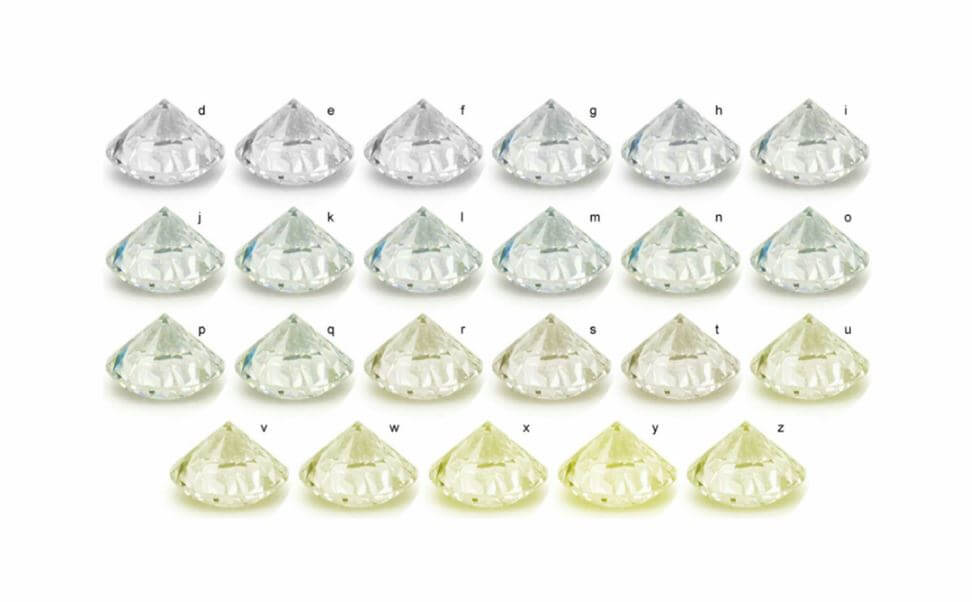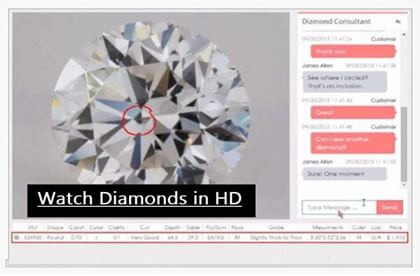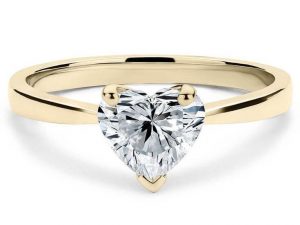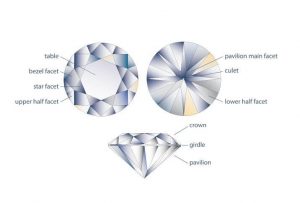The color of a diamond is a very important parameter for estimating the value of the diamond. There is something known as the 4Cs of diamonds (cut, color, clarity, and carat weight). After the cut of the diamond, the second most important factor is the color. This just shows how important the color of a diamond is. For me, the phrase “the color of a diamond” sounds more like a figure of speech than a literal statement. It seems to contradict what we grew up knowing. We all grew up thinking that diamonds are colorless solids. So to hear that phrase “the color of diamond” seems to be an issue. The good thing is diamonds are truly still colorless but there are also diamonds with colors. The colorfulness or colorlessness of a diamond is a measure of how good or bad the diamond is. In essence, the value of a diamond is affected strongly by the colors in it except in cases where the diamonds are considered fancy colors based on the type of color in it. All of these details will be discussed extensively in this article. Follow the ride.
The Color Scale for Diamonds
The importance of colors to the value of a diamond makes it requisite that there is a color scale that will be used to grade a diamond. Diamonds are expected to be colorless but it is not always the case. The diamonds without color are ranked high on the scale and are usually the most valuable. But other diamonds with colors are ranked based on the degree of color in it.
The popular scale used to grade diamonds uses letters of the Latin alphabet ranging from the letter D down to the last letter Z. That’s how many grades of diamond colors that we have. The first grade on this scale is the grade D. This grade is for diamonds that are the most colorless. A yellow tint or yellow coloration appears in the diamonds as you progress down the different grades of the diamond scale. The purity of the diamond reduces down the grade from D – Z, as the color increase. It is important to note the difference between the yellow tint in diamonds (that serves as the color in diamonds) and a fancy diamond with a yellow color. These fancy diamonds will be discussed down as we progress in the article.
The rarest diamonds to find in nature are the grade D diamond. This is because they are the most colorless diamonds. The bigger problem with this diamond is not just the fact that they are scare and hard to find in nature but also the fact that they are the ones people seek after the most. This scarcity, coupled with the high demand makes this grade of the diamond the most expensive of all the diamond grades. The grade D diamonds are by far the most expensive of all diamonds. The only exception to these is the fancy diamonds.
Ordinarily, it will be difficult, even impossible for a normal person to know the difference between two diamonds of adjacent or consecutive color grade. For instance, if a buyer is asked to determine the difference between a grade E and a grade F diamond, they might not be able to do so. If they eventually get to point out the difference, it will be after thoroughly looking at both and comparing them side by side for a while. Although the difference is hardly noticeable, the two diamonds are quite different, so it is important that they are grouped differently. Looking with the eye, the difference is hard to spot but the gap in the price can be quite huge for such hardly noticeable difference.
I know you are already wondering why the GIA color scale starts from the letter D instead of letter A (which would have been more appropriate alphabetically). The reason is simple. Although this color scale by the GIA has been in existence for a long while now and is now the industry standard for evaluating the color of a diamond, it is not the oldest color scale ever invented. There has been another scale before this that has used the letters A, B, C to grade the color of diamonds. So the GIA, while inventing their grading system decided to omit those letters. The main reason for doing this is to avoid confusion. So everyone is clear on what the GIA scale is.
Practical explanations of the diamond color chart
Colorless diamonds D – F: Diamonds that are classified under the D, E and F grades are considered colorless diamonds by the GIA. This implies that these diamonds do not have any yellow tint in them. These diamonds are the hardest and rarest to find in nature and they are also the group that is most sought after by buyers. This makes the colorless diamonds the most valuable diamonds. More valuable than other diamonds with lower grades on the diamond color scale. Except you compare them thoroughly side by side, you might not be able to spot the difference between the grade D and grade E diamonds. Sometimes even grades D & F are still difficult to differentiate. But this slight unnoticeable difference does not mean the difference in price will also be “slight unnoticeable”. When you compare the prices of the three grades together with all other factors being the same, the grade D diamond can cost as much as $9,500. The grade E diamond can cost $8,250. While the grade F diamond can cost $7,500. So there’s a whopping difference of $2,000 between grade D and grade F diamonds yet the difference between them is hardly noticeable.
Because these D – F diamonds are colorless, they will fit in perfectly with any setting you choose to set them in. It doesn’t matter if you are choosing a platinum setting or a white gold setting to set it in. these diamond are beautiful with all settings and their color/colorlessness is not affected by the setting.
Near colorless diamonds G – J: The next group of diamonds is the near-colorless diamonds. Near colorless means that they have color in them and cannot be referred to as colorless. Yet the color in them is so little that they look like they don’t have colors at all. The difference between the grade G and grade J diamonds is quite noticeable. Although GIA labels both as near colorless diamonds, you can more easily notice their difference when you hold both together in your hands. So it is a smarter move to differentiate the G – H GRADES from the I – J grades. Because they are different, unlike the colorless diamonds. Your preferred setting also helps to determine which of these near colorless diamonds you should be buying. If you are using a palladium ring, platinum or white gold setting, the best diamond grade is the G – H color grade. Yellow usually reflect on the diamond. So if you are going for a yellow gold setting, you should buy the H – I. diamond color. As much as possible, you should try to stay away from the J colored diamonds.
Faint color diamonds K – M: Diamonds on this group have a yellow tint on them that are visible to the naked eye. You do not need to be an expert or compare with other diamonds to notice the yellow coloration on these diamonds. The yellow coloration is indeed faint but not unnoticeable. This makes them very much less desirable than other diamonds in grades above them. Because they are less desired by buyers, the price for these diamonds is relatively very cheap when compared to the D – F and the G – J groups of diamonds. According to the law of economics, the price of a commodity is determined by the level of demand for that commodity. The most in-demand group of diamonds is the colorless group, followed by the near-colorless group (which many buy as a cheap substitute for the colorless group). This makes the gap in price between the near-colorless diamond and the faint color diamond unusually very high. Although this diamond group is relatively very cheap, it is worth noting that many diamond stores, even the most popular ones, do not have these groups of diamond in stock. This is due to the yellow coloration on the diamond which many buyers do not appreciate. Therefore leading to low demand and consequently, absence from stores.
If you are someone who doesn’t mind the yellow coloration. If you find it appealing, you could decide to go vintage and place it in a gold setting. But this is only possible if you somehow find it on the market and you’ll be really lucky to.
Very light color diamonds N – R: Diamonds in this group have easily noticeable color. This color might be a brown tint or a yellow tint. The prices for these diamonds are extremely low because the demand for them is equally very low. They are often referred to as top light brown.
Light color diamonds S – Z: These diamonds have a yellow coloration and surprisingly are more in demand in the market than the group above them. The obvious yellow tint of these diamonds has made people consider it a “yellow stone” (they are however not fancy stones). The grading of the intensity of the yellow diamond starts with fancy light. So the U – X grades and the Y – Z grades are considered as replacements for the faint yellow and the light yellow diamonds.
How does the color of a diamond affect its value?
Evaluating the value of a diamond involves a lot more than the 4Cs but that does not in any way diminish the importance of the 4Cs to evaluating the value of diamonds. They are the most important factors and more so colors are very important.
As you move down the color scale, the price of the diamond reduces. While there is no particular fixed price or percentage that accounts for the difference, the difference can be very significant.
When it comes to buying a diamond, the buyer should always seek to minimize and cut costs as much as possible. One very easy way to do this is to move down the step. This is what I mean by that. Rather than stick to buying a grade D diamond, which undoubtedly is the best, you can decide to move one step down the grade and buy the grade E diamond. The truth is no one would be able to tell the difference. No one would know that you are wearing a grade E diamond (which isn’t even bad to wear by the way). What they will see on you is a colorless diamond and they will appreciate its beauty. However, you will be able to save a lot of cash from that singular move. This move only makes sense when you are mostly dealing with the colorless diamonds, and in some cases too, near colorless diamonds. You could decide to buy a grade H instead of grade G too and it will save you some money too. But imagine going “down the step” to buy a grade L instead of a grade K. that is as meaningless a move as meaningless can be. They look similar and have similar prices as well and they both have a faint color. The question is what’s the point in moving down?
Fancy Color Diamonds
It was mentioned earlier in this article that the diamond color scale ran from D – Z (colorless diamonds to light color diamonds). There are however some diamond colors that do not fit into this color scale. They are known as fancy diamonds. These diamonds possess different colors ranging from black, blue, pink, yellow, gray, brown, red, purple, orange, violet, green and white. The white-colored diamond is not the normal white of a colorless diamond. They are fancy white
The colors in these diamonds are formed by particulates that are trapped in the diamond during the process of crystallization. These trapped particulates then give the diamond its color after it has crystallized. Boron, for example, is known to be the cause of the blue coloration of a blue fancy diamond and nitrogen is known to be the cause of the yellow color of a yellow fancy diamond.
These fancy diamonds are graded differently from the ‘normal’ diamonds and they have a more complex grading system. But the summary is that they are graded based on their color and the intensity of the color in them.
There are different grades for the intensity of the color. They are faint, very light, light, fancy light, fancy, fancy deep, fancy dark, fancy intense and fancy vivid. It is important to note though, that it is not all fancy diamond colors that come in all the different intensities. For example, the brown diamond does not come in fancy vivid intensity. Yellow diamonds do not also come in the fancy dark intensity as well. Another issue that makes the grading a lot more complicated is the fact that GIA can use up to 2 – 3 colors to describe the color of the fancy diamond. Examples of this are fancy yellow-brown diamonds and fancy gray-blue diamonds. There is a fancy yellow diamond, fancy brown diamond, fancy gray diamond, and fancy blue diamond. Yet these diamonds still many times appear in a combination of these colors, making everything a lot complicated for us!
As a result of these combinations, there are hundreds of different color combinations for fancy diamonds. This is very much unlike the ‘normal’ white diamond that has just 18 color grades from colorless to light color diamonds.
The value of these fancy diamonds is determined by the intensity of the color they possess and the rarity of their occurrence naturally. Fancy diamonds are usually very rare in occurrence. A lot more than the colorless diamonds. It is said that only one out of every 10,000 diamonds have this color. That is how rare they are. So in the case where you find a fancy diamond and it has a very high intensity, for instance, a fancy red diamond with a fancy vivid intensity, do not be surprised if they are a lot more expensive than the colorless diamonds.
How to save money on color
The apparent color of a diamond is actually affected by the environment it is set in and the color of the mounting. If a grade H diamond is set in a ring, it would appear like a colorless grade D diamond. If a diamond is also mounted in a yellow gold setting, it hides the yellow coloration in the diamond and the diamond appears less colorful than it actually is.
These two scenarios help you to save some money on your diamond. If you are set on a ring, rather than buy D, you can buy H. trust me, the difference in price between D and H is massive. If you are also mounting on a yellow gold setting, you can go as far down as H and I, knowing fully well that the yellow gold mounting will hide the slight yellow coloration on the diamond and make it appear colorless.
On a final note, it is necessary to know that as much as you want to wear a colorless diamond, you can do that smartly without breaking the bank.




